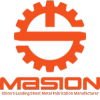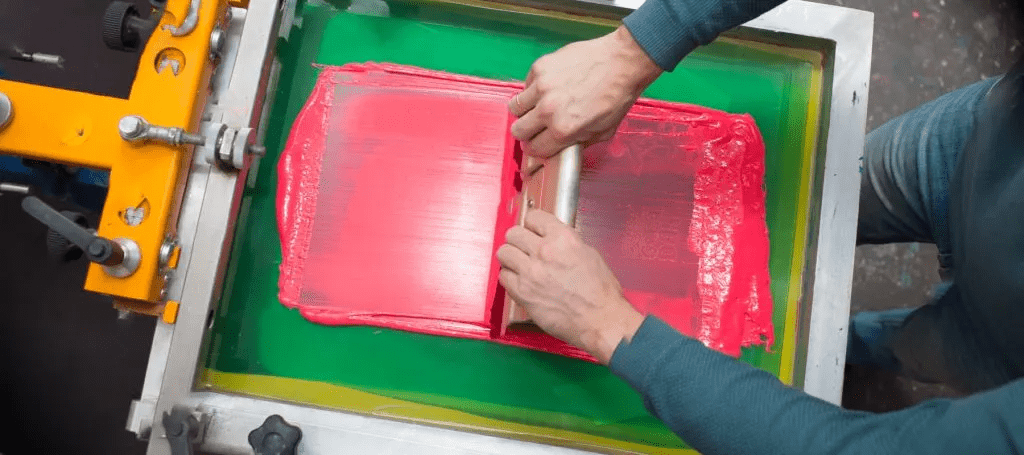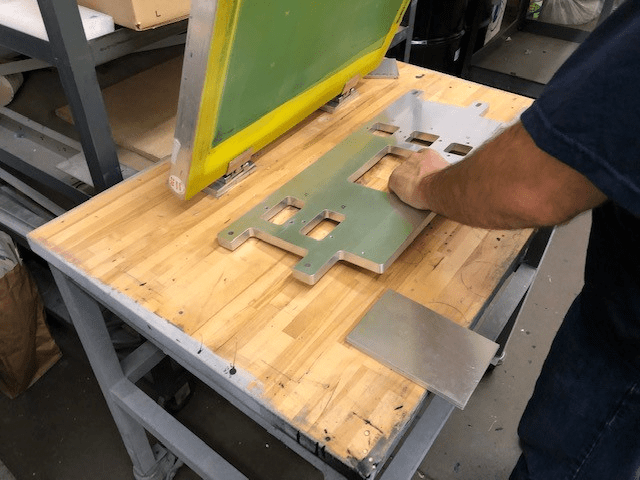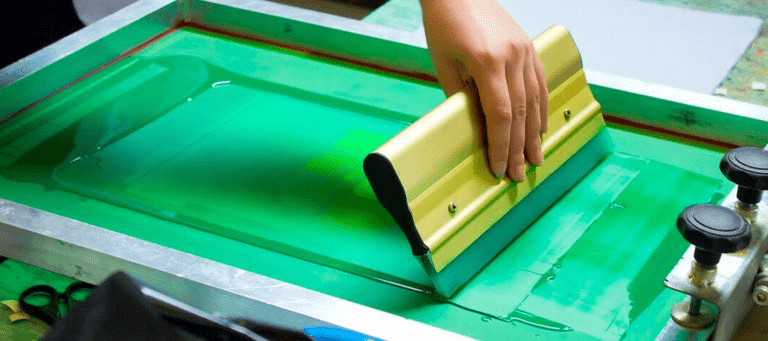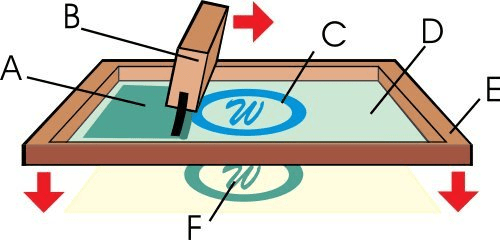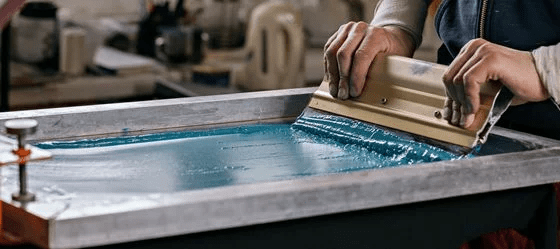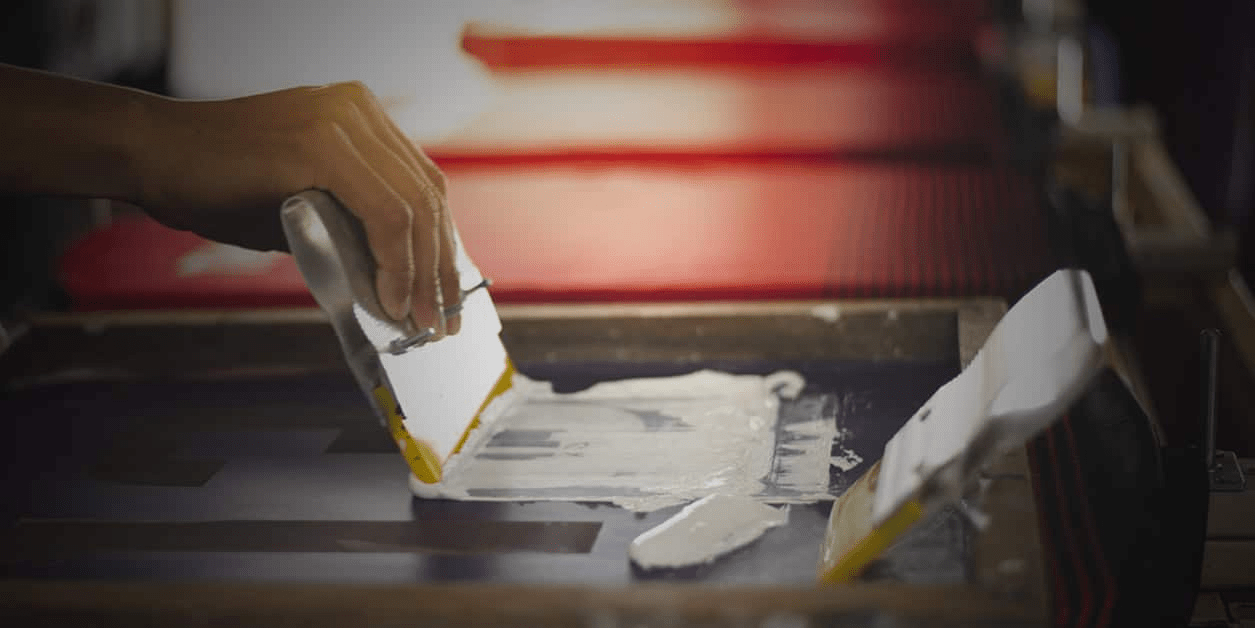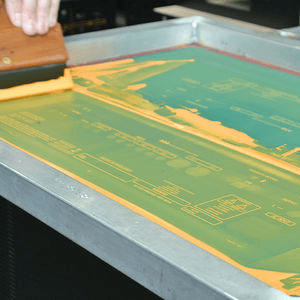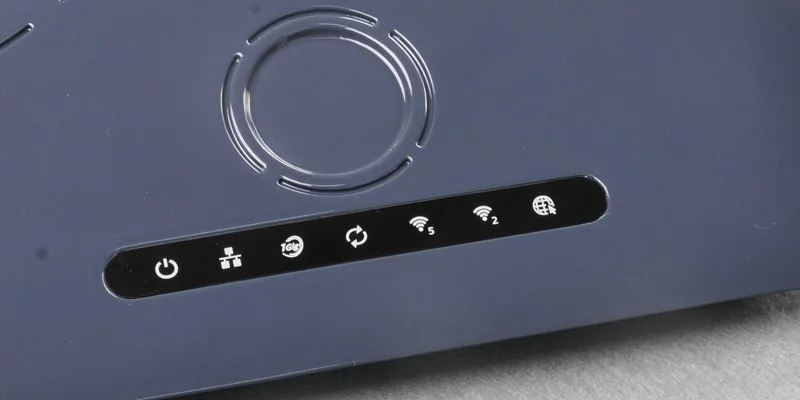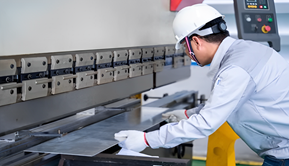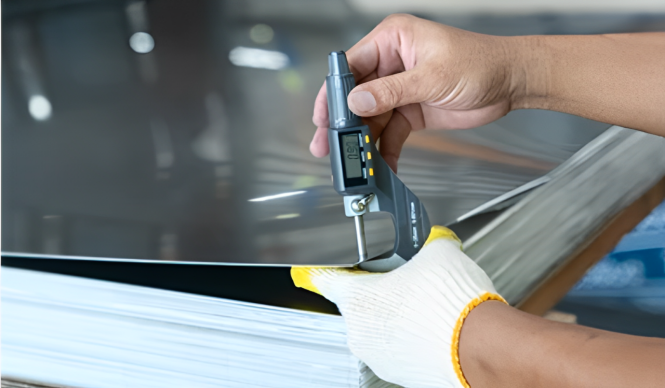Metal Silk Screen Printing- A step-by-step guide
Table of Contents
ToggleOverview of the process of silk screen;
Silk screen printing involves a process where the emulsion hardens when exposed to light except in areas shielded by the design. Afterward the screen is cleaned, leaving behind the design as a stencil.
Inks used for metal screen printing are typically solvent based or UV curable to ensure durability and adherence. While silk was traditionally used for this purpose modern practice often employs threads. This versatile process finds applications in industries like electronics and textiles creating durable designs. We know that ink selection for metal printing has great importance for durable images.
Screen printing on metal has gained popularity for transferring graphics, logos and text onto metal surfaces using a mesh screen, ink and a squeegee.
How many steps are involved in printing the silk screen procedure;
The printing process involves steps;
- Creating the Stencil; To create a stencil or screen block out areas where you don’t want the ink to pass through.
- Use of frame; A frame is used to keep the screen steady during the printing procedure.
- After using the frame you need to apply the Ink. So you can push the ink using a rubber-edged blade-like squeegee through the mesh.
The design is transferred onto the surface below using ink, which only penetrates the areas of the stencil.
Step 4; Drying or curing the ink is essential, for ensuring durability of the printed surface, which can be achieved through heat or UV light based on the type of ink utilized.
Step 5; Cleaning the screen is necessary to remove any remaining ink post printing allowing for its reuse.
Elaborate Silk screen printing technique;
We use this method for the fabrication of durable and good quality products such as we can produce
Clothing; hoodies for gents and children, t-shirts and it also print on some other clothing apparel
Posters; prints and posters.
Electronics; design markings on electronic components and printed circuit boards.
Metal Products; Branding and labeling on tools, signage and metal components.
While each application follows the principles of silk screen printing adjustments are made in materials and techniques to suit substrate requirements.
How many variations and types of this printing method?
We know proper knowledge of ink or substrate used in silk screens is critical for the success of your work. Its specific characteristics and features such as graphics on containers, metal signs and name plates show its durability and make it one of the exceptional methods.
Here are some common methods used for printing on metal surfaces;
Flatbed Screen Printing;
When it comes to printing on metal surfaces flatbed screen printing is the technique. It involves using a flatbed, a screen and a squeegee to transfer ink onto the metal sheet. This method is best suited for achieving prints, on slightly curved surfaces. It is commonly used in electronics for printing circuit boards in the industry for manufacturing dashboard components and in settings for branding and labeling equipment.
Rotating Screen Printing;
Rotary screen printing is well suited for cylindrical or rounded metal objects such as bottles, tubes and cans. The ink is applied while the metal item rotates using a screen and squeegee. This continuous process is especially beneficial for metal containers and promotional items like water bottles as it allows printing on curved surfaces.
Cylinder Printing;
Drum printing or cylinder press printing is utilized for mass producing metal sheets. Ink is applied by a squeegee as the metal sheet moves through a rotating screen. This rapid method ensures quality and efficiency making it an ideal choice, for large scale manufacturing operations.
Metal panels, signs and significant electrical parts are commonly produced using this method.
Color Screen printing
Precision alignment is crucial to ensure the final product is accurate. Even though this technique requires work it is essential, for producing vibrant and intricate visuals. Advertising materials, decorative metalwork and branded merchandise are a few examples of its applications.
UV Screen Printing
UV screen printing involves using light to dry and set the inks as they are UV curable. This technology offers advantages such as production speeds, enhanced durability and vivid color reproduction. It proves useful for products that need to withstand conditions like chemicals or wear over time. Industries, like automotive and electronics rely heavily on UV screen printing for creating lasting prints that can endure challenges.
Cleaning Silk Screen Printing;
To extend the lifespan of the stencil and maintain print quality cleaning of the screen is essential. The cleaning process involves;
- Removing Excess Ink; After printing make sure to scrape off any surplus ink from the screen.
When cleaning a screen, for silk screen printing start by washing it with a solvent or screen cleaner to remove any leftover ink. Different types of inks require cleaners. Based inks need stronger cleaners while water based inks can be cleaned with water. Next gently scrub the screen with a brush to remove any ink stuck in the mesh. Finally make sure the screen is fully air dried before storing or reusing it.
Regular cleaning is key to maintaining print quality and preventing ink buildup and clogging.
How long does silk screen printing last?
Prints can last for years without fading or wearing out significantly. Lots of factors such as care from weather conditions, quality of ink used for this printing method and surface preparation affect the durability and how much time this print will extend of silk screen printing lasts;
- Ink Quality; Premium inks designed for substrates are more resistant to deterioration and environmental factors.
- Surface Preparation; Adequate surface preparation ensures ink adhesion.
- Care; The longevity of a printed item depends on how its used and exposed to conditions.
Silk screen prints, on metal surfaces can last for decades if they are protected from weather conditions and other environmental elements.
How to use stencil for silk screen printing,
- Design Creation; Use design software to design the artwork.
- Printing the Design; Transfer the design onto a film or paper.
- Coating the Screen; Apply a emulsion to the screen and let it dry in a low light environment.
- Screen Exposure; Place the printed design on the screen.
- Washing; if you want to remove the emulsion, rinse it by using water. It will reveal the mesh areas of the pattern.
Achieving high quality screen prints relies on stencils produced through this process.
Why Applying silk screen is supposed to be an efficient strategy for metal and various other surfaces?
- Adhesion; Proper surface preparation and high quality inks ensure bonding to metal surfaces preventing peeling and fading.
- Having more coexistence and durability; The screen printing proves more durable and it is more resistant to corrosion than other digital methods offering less durability and corrosion resistance.
- Cost Effectiveness; Compared to printing methods silk screen printing is more affordable for medium to large production runs.
- Customization; Its flexibility in design and customization makes it ideal for labels, signs and decorative applications.
The above mentioned qualities of cost effectiveness, customization and adhesion make this method of silk screen printing one the best and most selected method for customers and manufacturing companies.
What type of items do we need to perform the silk printing procedure?
To achieve top notch prints that last long silk screen printing on metal necessitates materials;
The primary element is the screen printing frame, with mesh that maintains tightness to produce prints.
Polyester and stainless steel are typically the materials chosen for creating the mesh, with the mesh count varying based on the level of detail needed for printing.
Next a photosensitive emulsion is applied to the mesh followed by using an emulsion remover to clear it. This emulsion becomes hard and rigid to manufacture a stencil but it becomes stiff when we expose this emulsion to light. The screen can be reused in the future by employing an emulsion remover.
The exposure unit, a device that exposes the emulsion coated screen to light for transferring designs onto it serves as the component.
Inks specially formulated for metal surfaces are used in printing. They are often solvent based or UV curable for durability and adhesion assurance.
For ink adhesion degreasers and cleaning agents are essential, for cleaning both the metal surface and screen.
The metal object or sheet designated for printing is known as the “metal substrate.”
An expert company is the best place for getting desired results.In metal substrates,aluminum, stainless steel and brass are included.
What type of ink is utilised for the printing method?
Let me clear that why everyone should be have good knowledge and understanding of process, material use, and pros and cons of this process of printing,
It is because the option and selection of ink play a function in making prints that last prolonged and maintain quality.
The inks and pigments are available with various options; we also call these pigments as inks.
- One type is Solvent Based pigment ; We can use this ink for brilliant color effects, durability and unique look.
The ink type consists of pigments balanced in a solvent that vaporises. They can leave the colour on the metal surface or any other surface. Solvent based inks are unsusceptible to scrape, chemicals and weathering producing them immaculate. It is good for indoor and also for outdoor applications.
- UV Inks; These inks are fixed under ultraviolet (UV) light initiating a chemical reaction that quickly solidifies the ink. UV rectifiable inks propose durability, vibrant colors and excellent adhesion to metal surfaces. Moreover, this type of ink is environmentally friendly as it does not remove compounds (VOCs).
As we know that all methods used for printing or finishing are not compatible with all metals but silk screen printing has a great advantage of being suitable mostly for all metals.
Here are some key methods and best practices that ensure high quality prints, on metal;
Let’s know some best-known practices and methods we can use for high-quality prints whether you want it for metals or plastic or any other surfaces.
Proper Screen Preparation;
It is a step to ensure that the screen is covered with emulsion and accurately. The screen should be exposed is crucial for creating a stencil. The exposed appearance is also significant to have the mesh tensioned appropriately. This step can stop ink defamation or bleeding.
Clean Metal Surface;
A clean metal surface is one of the best practices that ensure good quality prints on metal surfaces and the metal surface is free of oxidation, mud and oil are fundamental for metal or any type of printing. Degreasing and sometimes abrasion like sandblasting may be necessary to ensure ink adhesion.
Controlled Environment;
A controlled environment is the 3rd practice we can employ. It is essential to maintain a controlled environment with temperature and humidity levels to assist in maintaining ink viscosity and curing requirements.
Ink Uniformity;
Regularly mixing the ink to maintain viscosity is important. Keeping the ink at the temperature during printing helps prevent issues, like clogging or uneven prints.
During the production process conducting checks, on prints helps in detecting and promptly fixing issues like misalignment, ink smudging or color discrepancies. This is achieved through the implementation of quality assessments for prints.
Glass, wood and metal surfaces are considered the best-adhering surfaces for metal printing. digital inks are not as cheap and durable as metal printing these digital prints do not prove such effective methods used for printing.
How can we classify variuos aplication or uses of silk screen printing on metal;
We apply this printing method in different industries due to its durability and as it one of the most demanding process.
1.. Signs; Printing logos, names and other information on metal nameplates and signs that need lasting visibility and resilience to external elements.
- Control Panels and Front Panels; These components are employed in manufacturing devices, control panels and equipment where labels, symbols and instructions are necessary.
- Decorative Items; Custom printing on metal pieces like plaques, trophies and artworks falls under this category.
- Industrial Components; Marking logos, part numbers and other crucial details, on parts to facilitate identification.
This process ensures that the prints can withstand conditions such as exposure to chemicals, UV radiation and fluctuating temperatures. For electriacal industry, manufacturers apply this method to make lables and panel marking and they maintained accuracy and functionality important for silk screen printing.
This includes labels, logos, conductive tracks and circuit board identification.
Moreover in the signage industry silk screen printing plays a role in creating both outdoor signs. This method produces colors and lasting prints that can endure UV exposure and weather conditions effectively. It is a choice for advertising boards, informational signs and traffic signs due to its durability, under environmental factors.
These prints are tailored to meet application needs.
What are the advantages of silk screen printing on metal;
Screen printing, also known as silk screen printing offers benefits when applied to metal surfaces. One key advantage is its versatility as it can be used on metals, like copper, brass, stainless steel and aluminum. Its capability to print on slightly curved surfaces makes it suitable for a range of applications from artistic endeavors to industrial purposes.
Another significant benefit is its lasting durability. Silk screen printing on metal uses UV inks designed to withstand environmental conditions such as exposure to chemicals, moisture and extreme temperatures. This makes it an ideal choice, for signs, industrial nameplates, control panels and other applications requiring resilience to wear and tear over time. This process offers a thick ink print designing having high level designs and color vibrancy. It is capable of reproducing patterns, fine lines and small text with accuracy, which is essential, for applications requiring precise graphics or labeling. This method can produce opaque colors, including inks that stand out on metal surfaces enhancing the visual appeal of the printed item.
An important benefit lies in its cost effectiveness for medium to production runs. Once the initial screen is created it can be used to produce a quantity of prints at a cost per print. Therefore silk screen printing proves to be a choice for organizations seeking to create sizable quantities of high quality printed metal objects.
How does this technique compare to printing methods for metal surfaces;
When comparing silk screen printing with printing techniques used on metal surfaces distinct advantages unique to silk screen printing become evident.
Digital Printing; Digital printing on metal is commonly employed for runs and customized projects due, to its setup and ease of design alteration. This efficiency stems from technologies enabling configuration.
When comparing silk screen printing, to printing it’s worth noting that digital prints may lack the durability and vibrant colors of the former. This is because the inks used in printing may not hold up well against wear and UV exposure making them less suitable for outdoor or industrial applications.
Pad printing on the hand offers a method for printing on metal surfaces, especially those that are uneven or curved. While pad printing may not be as fast or efficient as silk screen printing for areas it excels at detailed work in smaller areas.
For precision and durability unmatched by methods laser engraving stands out as a choice when print materials need to withstand tough conditions. In comparison silk screen printing tends to be less vibrant and more costly, than laser engraving. It also has limitations in terms of generating graphics focusing more on etching than lively designs.Offset printing, a known printing technique is capable of producing high quality images. Is efficient, for large scale production. Unlike some printing methods offset printing may have limitations in terms of the types of metals and surfaces it can work with.
Understanding Different Metal Substrates Before Screen Printing, on Metal
It’s crucial to have a grasp of the metal substrates before diving into screen printing on metal given their unique characteristics that significantly influence the printing process and final product quality. Metals like titanium, copper, brass, stainless steel and aluminum each have properties, corrosion resistance levels and surface energies.
For instance stainless steel is known for its strength and suitability for applications whereas aluminum stands out for its nature and resistance to corrosion – making it ideal for signage purposes.
To ensure optimal ink adhesion different metal substrates call for surface preparation methods. Stainless steel might require priming or abrasion steps while aluminum may simply need cleaning and anodizing treatment. The compatibility between ink and metal also hinges on the characteristics of each. While solvent based inks work well with metals, UV curable inks show promise with others.
The properties of the substrate play a role in determining how a printed design sticks and lasts over time. Metals with high surface energy like steel typically offer adhesion but necessitate proper pre treatment to maintain it. Understanding these nuances aids, in selecting the right ink types and surface preparation techniques that lead to prints boasting resolution and durability.
In conclusion;
Silkscreen offers top-notch results in detailed prints resistant to various environmental conditions. This method is particularly beneficial for medium to large scale production runs when compared to processes striking a balance between quality and cost that’s hard to beat.
While digital printing is versatile and easy to set up it falls short in longevity compared to methods. May not achieve the same vibrancy, in colors.
When it comes to designs and curved surfaces pad printing stands out. It may not be as effective, for large areas. Laser engraving, known for its precision and durability lacks the color options and can come with a hefty price tag. Although offset printing delivers high quality images it tends to be pricier. Requires a complex setup.
Ultimately the choice of printing method depends on the project requirements. Factors such as the type of metal used, desired longevity, design complexity and production volume play a role in decision making. Silk screen printing emerges as a solution for metal printing needs by combining durability, with aesthetic appeal.
